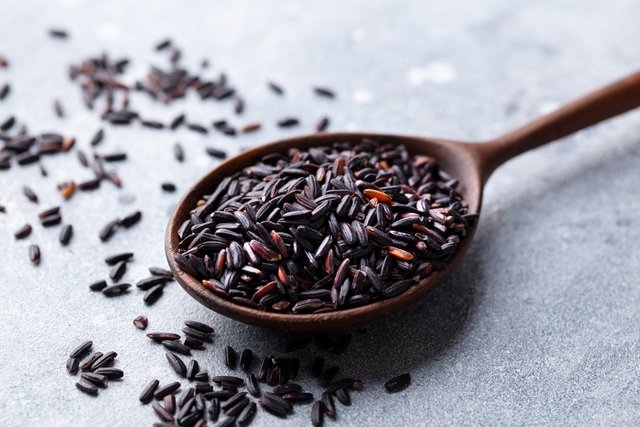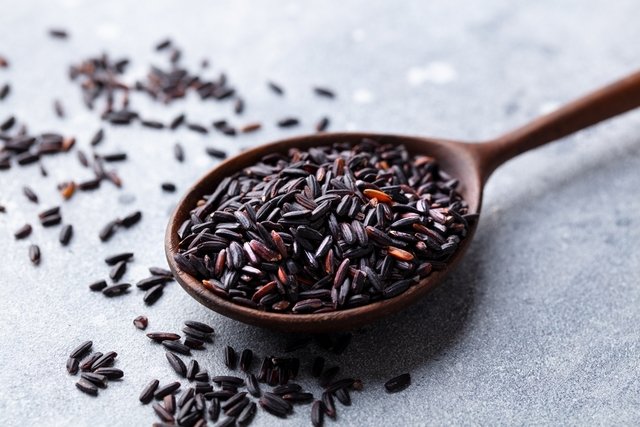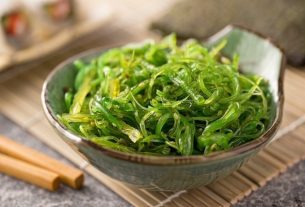Wild rice, also known as wild rice, is a very nutritious seed produced from aquatic algae of the genus Zizania L. However, although this rice is visually similar to white rice, it is not directly related to it.
Compared to white rice, wild rice is considered a whole grain and has twice the amount of protein, a greater amount of fiber, B vitamins and minerals such as iron, calcium, zinc and potassium.
Furthermore, wild rice does not contain gluten and is rich in antioxidants, mainly phenolic compounds, and, therefore, its regular consumption is associated with several health benefits, such as combating constipation and preventing cardiovascular diseases, for example. example.

Consuming wild rice can bring several health benefits, as it is a whole grain with antioxidant, anti-inflammatory, antimicrobial, hypoglycemic and hypolipidemic properties. Therefore, the main benefits of wild rice are:
1. Combat constipation
Wild rice is rich in fiber, which improves intestinal transit and increases the volume of feces, promoting, together with water consumption, the exit of feces.
2. Promotes weight loss
Wild rice is rich in protein and fiber, increasing the feeling of satiety and helping to regulate insulin. Furthermore, the protein present in this type of rice is of high biological value and, therefore, together with a protein-rich diet and physical activity, it can also help to gain muscle mass.
3. Helps prevent cardiovascular disease
Some scientific studies indicate that consuming wild rice helps reduce “bad” cholesterol, LDL, preventing the formation of atheromatous plaques and reducing the risk of heart disease, due to its antioxidant properties and the presence of fiber in its composition.
4. Helps control blood sugar
The fiber present in wild rice slows the absorption of carbohydrates in the intestine, causing glucose to progressively increase in the blood, stimulating adequate insulin activity.
5. It is rich in antioxidants
Wild rice, as it is rich in antioxidant compounds, mainly phenolic compounds and flavonoids, helps to reduce oxidative stress and protect the body’s cells from damage caused by free radicals, thus preventing premature aging of the skin and the development of chronic diseases and cancer.
Nutritional composition
The following table shows the nutritional composition of wild rice per 100 grams, in addition to being compared to white rice:
How to prepare wild rice
Compared to white rice, wild rice takes longer to prepare, around 45 to 60 minutes. Therefore, you can cook wild rice in two ways:
- Add 1 cup of wild rice and 3 cups of water with a pinch of salt, over high heat until it boils. As soon as it boils, put on low heat, cover and let it cook for 45 to 60 minutes;
- Leave to soak overnight and repeat the procedure mentioned above and let it cook for around 20 to 25 minutes.
Some recipes that can be prepared with wild rice are:
1. Watercress salad with wild rice
Ingredients
- 1 package of watercress;
- 1 medium grated carrot;
- 30 g of walnuts;
- 1 cup of wild rice;
- 3 cups of water;
- Olive oil and vinegar;
- 1 pinch of salt and pepper.
Preparation mode
Once the wild rice is ready, you must mix all the ingredients in a container and season with olive oil and vinegar. Another option is to prepare a lemon vinaigrette and for this you need the juice of 2 lemons, olive oil, mustard, chopped garlic, salt and pepper, mix everything and season the salad.
2. Wild rice with vegetables
Ingredients
- 1 cup of wild rice;
- 3 cups of water;
- 1 medium onion;
- 1 clove of chopped garlic;
- 1/2 cup diced carrot;
- 1/2 cup of peas;
- 1/2 cup of green beans;
- 2 spoons of olive oil;
- 1 pinch of salt and pepper
Preparation mode
In a frying pan, add two tablespoons of olive oil and sauté the onion, garlic and vegetables, leaving for about 3 to 5 minutes or until they are soft. Then add the ready-made wild rice, add a pinch of salt and pepper and mix.
See in more detail in the following video how to prepare wild rice with vegetables:
Bibliography
- HWAN Sun. Diets for Constipation. Pediatric Gastroenterology, Hepatology and Nutrition. Vol 17. 4 ed; 203-208, 2014
- U.S. DEPARTMENT OF AGRICULTURE. Food Data Central: Wild Rice. Available at: <https://fdc.nal.usda.gov/fdc-app.html#/?query=wild%20rice>. Accessed on February 4, 2020
- SURENDIRAN GANGADARAN, ALSAIF MAHA et al. Nutritional constituents and health benefits of wild rice (Zizania spp.). Nutrition Reviews. Vol 72. 4 ed; 227-236, 2014
- QIU Yang. Antioxidant activity of commercial wild rice and identification of flavonoid compounds in active fractions. Master’s thesis, 2009. The University of Manitoba.
- STATE UNIVERSITY OF CAMPINAS – UNICAMP. Brazilian Food Composition Table.. 2011. Available at: <http://www.nepa.unicamp.br/taco/contar/taco_4_edicao_ampliada_e_revisada.pdf?arquivo=taco_4_versao_ampliada_e_revisada.pdf>. Accessed on February 4, 2020
- STATE UNIVERSITY OF CAMPINAS – UNICAMP. Brazilian Food Composition Table. 2011. Available at: <http://www.nepa.unicamp.br/taco/contar/taco_4_edicao_ampliada_e_revisada.pdf?arquivo=taco_4_versao_ampliada_e_revisada.pdf>. Accessed on 03 Feb 2020
- QIU Yang. Antioxidant activity of commercial wild rice and identification of flavonoid compounds in active fractions.. Master’s Conclusion, 2009. The University of Manitoba.

Sign up for our newsletter and stay up to date with exclusive news
that can transform your routine!
Warning: Undefined array key "title" in /home/storelat/public_html/wp-content/plugins/link-whisper-premium/templates/frontend/related-posts.php on line 12
Warning: Undefined array key "title_tag" in /home/storelat/public_html/wp-content/plugins/link-whisper-premium/templates/frontend/related-posts.php on line 13





